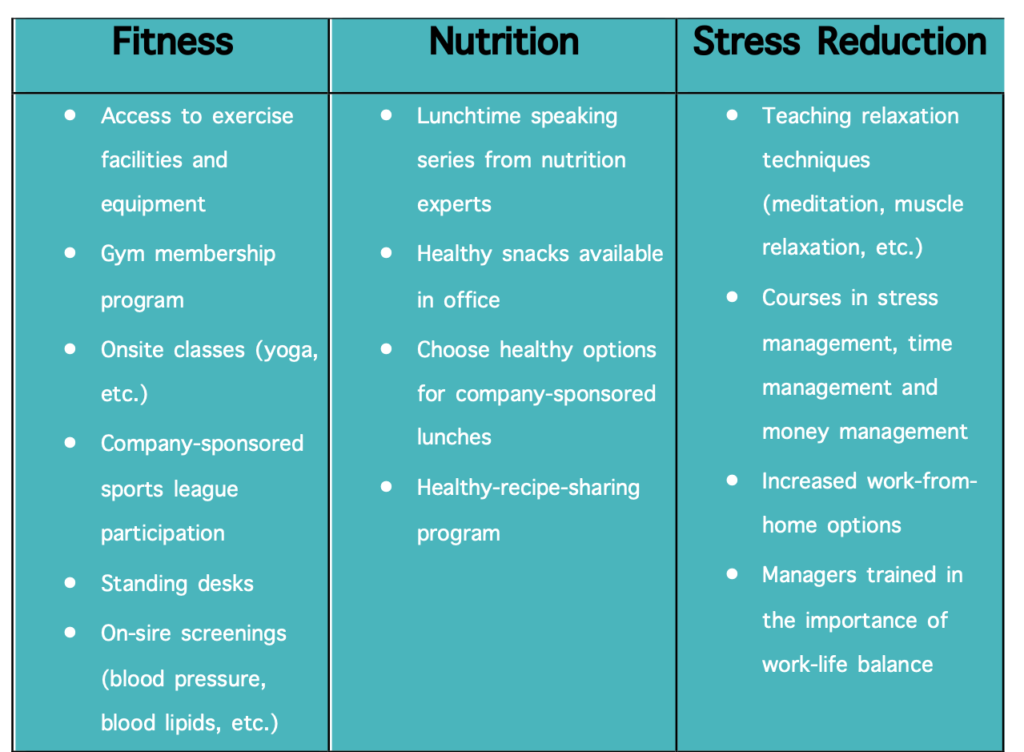Is Your Employee Wellness Program Working?

Employee wellness isn’t just about fitness. Use these six tips to create a holistic wellness program that improves your bottom line, no matter how large or small your firm is.
Over thirty years ago, I took a headfirst dive into the world of employee wellness programs. I was working on my PhD in Applied Exercise Physiology at Texas A&M when the director of our lab came to me with a question: Was I interested in working on an evaluation of the wellness program at the big Westinghouse plant down the road in College Station? This plant, employing over 2,000 people to create radar components for fighter planes, had recently launched the program, with a beautiful new fitness center as its centerpiece.
“Sure,” I said.
Thus began my eight-year involvement with Westinghouse, measuring the profitability and effectiveness of their employee wellness and consulting them on improvements. And thus began a career that would later see me consulting on several other large-scale employee wellness programs, from Norwegian shipbuilders to the State of Texas.
If you lead an organization of more than 200 employees, it’s likely you already have some sort of employee wellness program (around 90 percent of US businesses above this size offer one). But all wellness programs are not created equal, not by a long shot. You may also lead a smaller company and wonder how you can get one started without blowing your budget. Either way, it’s worth assessing how your organization supports employee wellness. Especially today, a smart, well-run wellness program can be a major asset, improving everything from your healthcare spend to employee engagement to your appeal to talented job seekers.
Here are my top six tips for optimizing your employee wellness program, gathered over three decades of work evaluating and consulting on them.
1. The CEO must be on board.
For any wellness program to be successful, the CEO has got to take an interest. This is obvious from a financial standpoint. The day will come when decisions must be madeabout whether certain resources are allocated toward the program or not. If the CEO is unwilling to do devote any resources (even if it’s just employee time), the program will fail.
But, more importantly, the CEO and the executive team are also critical in setting an example when it comes to prioritizing wellness and participating in the program. For example, when I first came to Sam Houston State University, where I still teach, the health and kinesiology center was seldom used by faculty. Across the whole campus, there were maybe half a dozen people who you’d see in the faculty locker room consistently. But then we got a new president. He was a big advocate of fitness, and he visited the health center no fewer than three days a week. Suddenly, the faculty locker room was bustling with people working out and being active. The president’s participation was contagious, and faculty wanted him to see that they shared his enthusiasm for fitness.
The same will be true at your business. If the CEO and executive team don’t have buy in and involvement in the program, if they never talk about it and aren’t seen participating themselves, it is likely to come across like an HR afterthought. And you will see limited benefit from it.
2. It’s not just about fitness.
Probably the most common mistake I see when I’m brought in to evaluate an employee wellness program—especially at larger companies—is the mindset that “employee wellness” equals “fitness.” Many leaders are narrowly focused on the construction of a fitness center or the purchase of workout equipment.
I myself am a big advocate of fitness, but there’s much more to a holistic employee wellness program. In fact, fitness is just one of three pillars, the other two being nutrition and stress reduction. These other two carry just as much weight as fitness when it comes to delivering the outcomes we care about. We’ve known since the time of Hippocrates that we should let food be our medicine, and more than ever, stress is reaching epidemic levels in terms of the impact on employee health. A great wellness program recognizes each of the three pillars. Fortunately, implementing the stress and nutrition components usually gives you a much bigger bang for your buck—costing significantly less than purchasing fitness equipment and building exercise facilities. In fact, if a board came to me today and asked where they can get the most value from a wellness program, I’d point them immediately toward stress-reduction programs.
Three components of employee wellness

3. Partner with the community.
As I mentioned, you don’t have to lay out a ton of money to put together a great employee wellness program. If you lead a smaller company and don’t have budget for wellness staff or facilities, there’s still plenty you can do, especially by drawing upon the resources already in your company and your community.
First, find a person (or small group of people) in the company who is already wellness-minded. See if they are interested in spearheading your wellness program. Once you find your internal point person, relieve them of some of their regular duties to make room for this initiative. The next step is to help your point person seek out health resources in the local community they can plug your organization into. You would probably be surprised by how many organizations are willing to do health screenings and educational programming at your company for a nominal fee, whether it’s the American Heart Association, the American Cancer Society, or even local hospitals and health systems. Any time these organizations can get their name in front of a decent-sized group of people, they will usually be eager to do so. That’s something you and your wellness point person can take advantage of as you put together a low-cost program. It’s a win-win for both parties.
4. Measure success.
When I was at Westinghouse in the 1980s, we had the advantage of working in a highly regimented plant environment where we could measure productivity in a fairly objective way. As employees produced parts for fighter planes, they logged their progress in a computer system, so I could see a wealth of productivity data for each person. I could see that Joe Smith, for example, completed X number of boards from August until January with a Y percent rejection rate, with tremendous access to all the granular underlying data. And I could see whether Joe’s productivity went up, down, or stayed the same as he attended the fitness center and took part in other health initiatives.
In the decades since, a lot has changed in the corporate world. Today, it’s very rare to find an objective measure of productivity. Employees are increasingly doing knowledge work, and their productivity often comes down to their supervisor’s subjective opinion. But there are plenty of other things you can still track.
Far and away, controlling healthcare costs is the metric most leaders care about when they implement a wellness program. Tracking these costs is indeed an effective way to measure how a wellness program is doing (even though many other factors, of course, affect healthcare cost). I would recommend having a system that shows how a certain employee or cohort of employees’ participation in the wellness program correlates to their healthcare cost over the long term.Beyond heathcare cost, I also recommend tracking metrics like absenteeism, employee engagement (via survey responses), employee turnover, and percent of employment offers accepted—all of which can be positively affected by a great employee wellness program. Any efforts you make to support employee wellness will almost certainly have a positive effect, even if it’s small and hard to measure. But it is important to track the outcomes you care about most to determine how your wellness program is performing and how it might be improved.
5. Incentivize participation.
In a perfect world, your staff would be intrinsically drawn to participate in your wellness program. But in reality, you’ll get the best results from kick-starting participation by strategic use of incentives.
Fortunately, you don’t have to drop a lot of money. At several companies, we gamified the process through a points system. Once employees rack up a certain amount of points, they get special recognition and small prizes like a water bottle or T-shirt. Don’t underestimate the usefulness of these measures. It’s shocking what people will do for a T-shirt. At other companies, we saw significant traction from allowing people to earn paid time off through participation.
But there’s one other incentive that I’ve found to be the most significant. Which leads us to the final tip . . .
6. If you have wellness staff, they need to be excellent.
In larger companies that have full- or part-time wellness staff—whether it’s nutritionists, trainers, wellness directors, or otherwise—the quality of these individuals is probably the biggest factor in employee participation and the overall success of the program. If these people aren’t well-trained professionals that employees actually want to be around, the program is not going to be successful. Period. I’m currently working with the Texas Department of Criminal Justice as they hire, train, and certify a new team of wellness professionals, and getting great people with a personal touch is at the forefront of our minds.
Ultimately, it’s up to you, the CEO—in partnership with your executive team, HR team, and/or appointed wellness point person—to create a wellness program that fits your organization’s culture, work environment, budget, and goals. But keeping these six tips in mind will keep you from the pitfalls I’ve seen many others fall into.
One final word for the CEO: Don’t forget about your own wellness. You have a tremendous amount of stress placed on you. Being able to handle that stress— whether it’s by running three miles a day or going to a progressive muscle relaxation class—is critical not only for modeling wellness for your workforce but for keeping yourself at the very top of your game.






